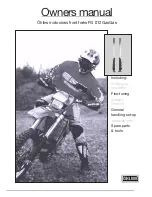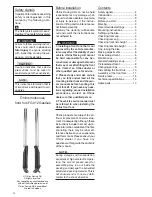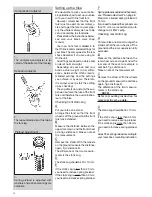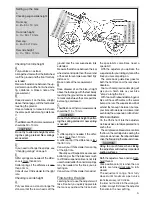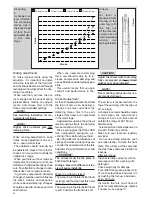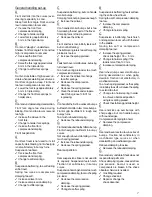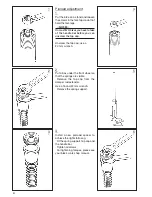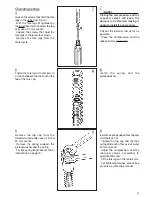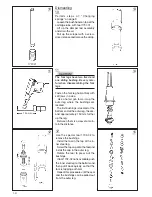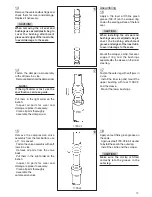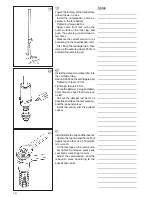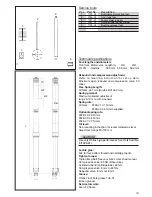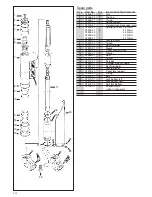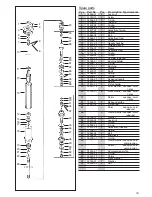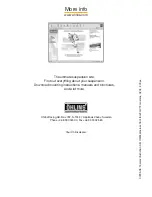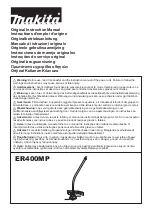
6
CAUTION!
Adjust the oil level with the fork leg
fully compressed and no preload
washer nor spring installed.
NOTE!
See mounting instruction for rec-
ommended oil level.
The oil level is measured from the
top of the outer leg, with the top nut
off, see fig 6.
A change in oil level should be made
in small steps. We recommend a
change of 5 mm at a time and not
outside the range of 90-130 mm.
Maintenance
Telescopic front forks depend on a
smooth, friction free action.
Make sure your forks are regularly
serviced.
Do not use strong solvents, such
as brake cleaner, to clean the front
forks. This will dry out the seals and
the steel tubes and cause friction or
leakage.
After every race:
Clean externally and spray with an
all-purpose oil after washing with
detergent.
Check externally for damage.
Put a little Öhlins green grease (148-
01) on the steel tubes and work it in
by pushing the fork up and down.
Every 20 hours:
Dismantle the fork and check all
parts for wear and damage, replace
if necessary, see page 10.
Making adjustments
To make improvements using the
adjusters, it is important to under-
stand the function of the front fork
and the shock absorber and through
testing learn how they effect the han-
dling of your bike.
Make sure that you have the cor-
rect springs and the correct spring
preload before making any adjust-
ments. And always start with the
Öhlins recommended settings:
NOTE!
See mounting instruction for rec-
ommended settings.
NOTE!
Higher click numbers give less
damping force.
When making adjustments; keep
notes, make adjustments one at a
time... and in small steps.
The adjusters should normally not
be adjusted in steps of more than 2
clicks at a time and not outside the
usable click range.
When you think you have made an
improvement, go back to what you
started with and double check to be
sure. Pay attention to changes in con-
ditions like tires, temperatures etc.
In general, compression damping
changes should be used to influence
the bike’s stability and response,
while rebound damping changes
should be used to influence comfort
and traction.
When you need more damping
force, you should mainly try to in-
crease compression damping and
use as little rebound damping as pos-
sible.
This usually means that you gain
comfort and performance in han-
dling.
Oil level adjustment
As the air trapped between the oil and
the top nut acts as an air-spring, a
change in oil level will effect the
damping forces. Not in the early
stage of fork travel, but a great deal
in the later stage.
A general description of how the oil
level/air-spring effects the damping
forces are shown in fig 5.
The air-spring gives the Öhlins USD
fork a progressive spring rate, pre-
venting it from bottoming out hard.
By using different combinations of
springs and oil levels/air-springs you
can alter the characteristic of the fork
and tailor it to suit different tracks and
conditions.
CAUTION!
The oil level must be the same in
both front fork legs.
Riding a bike with different oil lev-
els will cause instability.
When the oil level is raised:
The air-spring in the later half of travel
is strong, and thus the front fork hard.
When the oil level is lowered:
The air-spring in the later half of travel
is soft, and thus the front fork soft.
Oil level
6.
Oil level is
measured from
the top of the
outer leg, with
the top nut
off,the fork fully
c o m p r e s s e d
and no preload
washer nor
spring installed.
Air spring
5.
A change in oil
level will effect
the damping
forces, not in
the early stage
of fork travel
but a great deal
in the later
stage.
Oil level
5 0 0
4 5 0
4 0 0
3 5 0
3 0 0
2 5 0
2 0 0
1 5 0
1 0 0
5 0
0
F
o
r
c
e
k
g
f
Stroke mm
0
2 0
4 0
6 0
8 0
1 0 0
1 2 0
Oil level 100 mm
Oil level 110 mm
Oil level 120 mm
Oil level 130 mm
Force
Stroke

